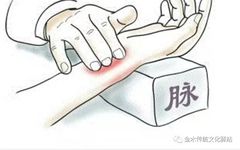The method of pulse diagnosis in Traditional Chinese Medicine (TCM) refers to the technique where the physician uses their fingers to palpate the patient’s arterial pulse to investigate the pulse quality, thereby understanding the patient’s condition.

The pulse-taking sites can be divided into three methods: comprehensive examination, three regions examination, and cun-kou examination. The most commonly used are the cun-kou method. The cun-kou is located at the radial artery pulse point behind both wrists, divided into three sections: cun, guan, and chi. The guan is at the high bone of the palm, the cun is before the guan, and the chi is behind the guan. The cun-kou pulse can reflect the qi of the organs: the left cun reflects the heart and small intestine; the left guan reflects the liver and gallbladder; the left chi reflects the kidney and bladder; the right cun reflects the lung; the right guan reflects the spleen and stomach; the right chi reflects the kidney.
When taking the pulse, attention should be paid to the time, posture, and technique. The examination should be conducted in the morning when the patient is inactive. If the patient has been active, they should rest for about 15 minutes before the pulse diagnosis. The patient can be seated or lying down, with the arms extended and palms facing up, bringing the arms close to the same level as the heart. During the pulse-taking, three fingers should press simultaneously, with balanced pressure, ranging from light to heavy, categorized into three types of pressure: superficial, moderate, and deep. The pulse diagnosis should last no less than one minute.
A healthy pulse should beat four times with each breath, with pulses present in the cun, guan, and chi sections, neither floating nor sinking, and should be gentle yet strong. The chi pulse should be strong when taken deeply.
Common pulse types include: floating pulse, sinking pulse, slow pulse, rapid pulse, weak pulse, strong pulse, slippery pulse, surging pulse, fine pulse, and wiry pulse.
1. Floating Pulse

[Body Image Song] Floating on the skin, like wood floating on water; lifting it shows excess, pressing it shows deficiency.
[Main Disease Song] Floating pulse is yang, indicating a disease on the surface. A floating pulse at the cun indicates wind; a floating pulse at the left guan indicates wind in the middle jiao; a floating pulse at the right guan indicates phlegm and wind in the diaphragm; a chi pulse indicates wind in the lower jiao, with difficulty in urination and constipation.
[Combined Pulse Song] Weak indicates surface deficiency, strong indicates surface excess. Floating tight indicates wind-cold, floating slow indicates wind-stroke; floating rapid indicates wind-heat, floating slow indicates wind-damp. Floating empty indicates blood loss, floating short indicates qi deficiency; floating surging indicates empty heat, floating weak indicates heat exhaustion; floating rough indicates blood injury, floating moist indicates qi failure.
2. Sinking Pulse
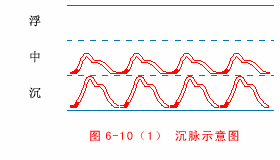
[Body Image Song] Sinking moves through the muscles and bones, like a stone thrown into water; pressing it shows excess, lifting it shows deficiency.
[Main Disease Song] Sinking pulse is yin, indicating a disease inside. A sinking pulse at the cun indicates shortness of breath and chest pain; it may be phlegm or fluid. A guan pulse indicates internal cold, causing pain and fullness; it may be acid reflux and muscle tension. A chi pulse indicates back pain and also indicates lower body dampness and itching. Frequent urination and diarrhea may also be present.
[Combined Pulse Song] Weak indicates internal deficiency, strong indicates internal excess. Sinking slow indicates chronic cold, sinking rapid indicates internal heat; sinking slippery indicates phlegm and fluid, sinking rough indicates blood stasis; sinking weak indicates deficiency and decline, sinking solid indicates accumulation; sinking tight indicates cold pain, sinking slow indicates damp cold.
3. Slow Pulse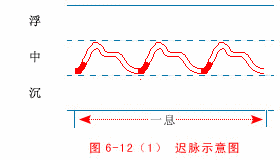
[Body Image Song] Slow pulse belongs to yin, characterized by insufficient movement; it comes slowly, three beats per breath.
[Main Disease Song] Slow pulse indicates organ issues, often due to cold. A slow pulse at the cun indicates upper cold, causing chest pain; a slow pulse at the guan indicates middle cold, leading to muscle spasms; a slow pulse at the chi indicates fire decline, with difficulty in urination and bowel movements, or pain in the lower back and legs.
[Combined Pulse Song] Strong indicates accumulated cold, weak indicates deficiency cold. Floating slow indicates surface cold, sinking slow indicates internal cold; slow rough indicates blood deficiency, slow soft indicates damp cold; slow slippery indicates fullness, slow weak indicates discomfort.
4. Rapid Pulse
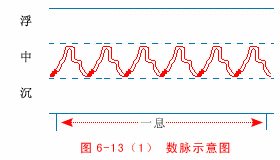
[Body Image Song] Rapid pulse belongs to yang, characterized by excess; six beats per breath, coming and going quickly.
[Main Disease Song] Rapid pulse indicates issues with the bowels, often due to heat. A rapid pulse at the cun indicates wheezing and coughing, with mouth sores; a rapid pulse at the guan indicates stomach heat, with evil fire attacking; a rapid pulse at the chi indicates fire in the lower jiao, with difficulty in urination.
[Combined Pulse Song] Strong indicates real fire, weak indicates false fire. Floating rapid indicates surface heat, sinking rapid indicates internal heat. Yang rapid indicates fire excess, yin rapid indicates fire deficiency. Right rapid indicates excessive fire, left rapid indicates yin damage.
5. Slippery Pulse
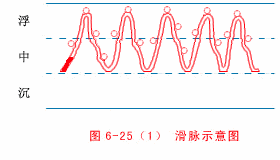
[Body Image Song] Slippery pulse flows smoothly, like beads rolling; it has a round shape, indicating moisture.
[Main Disease Song] Slippery pulse is yang, often indicating phlegm and fluid. A slippery pulse at the cun indicates coughing; a slippery pulse at the guan indicates stomach heat, with fullness and food injury; a slippery pulse at the chi indicates issues with urination, or may indicate diarrhea, with men experiencing blood in urine and women experiencing menstrual issues.
[Combined Pulse Song] Floating slippery indicates wind phlegm, sinking slippery indicates phlegm food. Slippery rapid indicates phlegm fire, slippery short indicates qi blockage. Slippery and floating indicates pain in the lower body; slippery and floating indicates stroke paralysis. Slippery and harmonious indicates pregnancy can be determined.
6. Rough Pulse
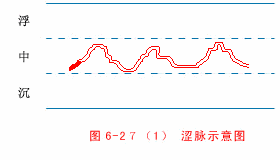
[Body Image Song] Rough pulse is obstructed, like cutting bamboo; it is slow, fine, and short, indicating fear.
[Main Disease Song] Rough indicates blood deficiency, also indicating essence injury. A rough pulse at the cun indicates heart pain, or may indicate anxiety. A rough pulse at the guan indicates yin deficiency, leading to internal heat; a rough pulse at the right guan indicates earth deficiency, while the left guan indicates fullness. A rough pulse at the chi indicates issues with urination, while a rough pulse at the chi indicates blood loss; during pregnancy, it indicates fetal issues, while lack of pregnancy indicates blood depletion.
[Combined Pulse Song] Rough and strong indicates real heat; rough and weak indicates false heat.
7. Weak Pulse
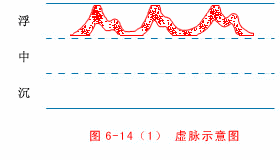
[Body Image Song] Weak pulse is small and soft, felt in the sinking section; it is barely felt when lifted, but can be felt when pressed.
[Main Disease Song] Weak indicates yang deficiency, true qi weakness. A weak pulse at the cun indicates heart deficiency, with anxiety and forgetfulness; a weak pulse at the right cun indicates lung deficiency, with spontaneous sweating and shortness of breath. A weak pulse at the left guan indicates liver injury, with blood not nourishing the muscles; a weak pulse at the right guan indicates spleen cold, with food not digesting. A weak pulse at the left chi indicates water decline, with weakness in the lower back and legs; a weak pulse at the right chi indicates fire decline, with cold symptoms.
8. Strong Pulse
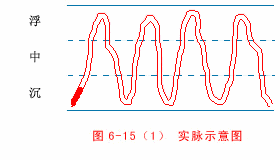
[Body Image Song] Strong pulse is powerful, long, and firm; it responds strongly to pressure, indicating all three sections are strong.
[Main Disease Song] Blood strong pulse indicates heat and blockage. A strong pulse at the left cun indicates heart strain, with strong tongue and qi surging; a strong pulse at the right cun indicates lung disease, with nausea and throat pain. A strong pulse at the left guan indicates liver fire pain; a strong pulse at the right guan indicates fullness and pain. A strong pulse at the left chi indicates constipation and abdominal pain; a strong pulse at the right chi indicates excessive fire.
[Combined Pulse Song] Strong and tight indicates cold accumulation; strong and slippery indicates phlegm blockage.
9. Long Pulse
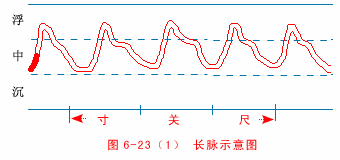
[Body Image Song] Long pulse is long and straight, with both ends clear; it moves straight up and down, like following a long pole.
[Main Disease Song] Long indicates excess, with qi reversal and fire excess. A long pulse at the left cun indicates yang fire disease; a long pulse at the right cun indicates fullness and reversal. A long pulse at the left guan indicates wood excess; a long pulse at the right guan indicates earth fullness and bloating. A long pulse at the left chi indicates excessive movement; a long pulse at the right chi indicates excessive fire.
10. Short Pulse
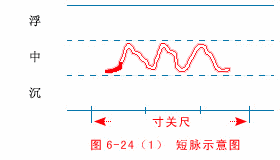
[Body Image Song] Short pulse is small and tight, with both ends curled; it protrudes in the middle, unable to fill the entire section.
[Main Disease Song] Short indicates insufficiency, representing qi deficiency. A short pulse at the cun indicates mental instability; a short pulse at the right cun indicates lung deficiency and headache. A short pulse at the left guan indicates liver qi injury; a short pulse at the right guan indicates issues in the diaphragm. A short pulse at the left chi indicates pain in the lower abdomen; a short pulse at the right chi indicates insufficient fire.
11. Surging Pulse
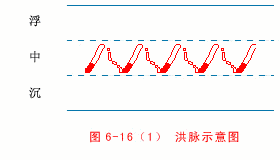
[Body Image Song] Surging pulse is extremely large, resembling a flood; it comes strong and goes gently, flowing abundantly.
[Main Disease Song] Surging indicates fullness, with qi blockage and fire excess. A surging pulse at the left cun indicates heart distress; a surging pulse at the right cun indicates chest fullness and qi reversal. A surging pulse at the left guan indicates excessive wood; a surging pulse at the right guan indicates bloating and heat. A surging pulse at the left chi indicates water depletion; a surging pulse at the right chi indicates excessive fire.
12. Fine Pulse
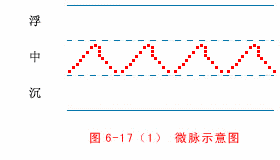
[Body Image Song] Fine pulse is extremely thin and soft; it is almost imperceptible, yet not completely absent.
[Main Disease Song] Fine pulse indicates severe qi and blood deficiency. A fine pulse at the left cun indicates anxiety; a fine pulse at the right cun indicates shortness of breath. A fine pulse at the left guan indicates cold contraction; a fine pulse at the right guan indicates stomach cold. A fine pulse at the left chi indicates extreme weakness; a fine pulse at the right chi indicates yang decline.
13. Moist Pulse
[Body Image Song] Moist pulse is fine and soft, felt in the floating section; it is visible when lifted, but empty when pressed.
[Main Disease Song] Moist indicates yin deficiency, with essence depletion. A moist pulse at the left cun indicates forgetfulness and anxiety; a moist pulse at the right cun indicates spontaneous sweating. A moist pulse at the left guan indicates blood not nourishing the muscles; a moist pulse at the right guan indicates spleen deficiency and dampness. A moist pulse at the left chi indicates essence and blood depletion; a moist pulse at the right chi indicates fire decline and life-threatening conditions.
14. Weak Pulse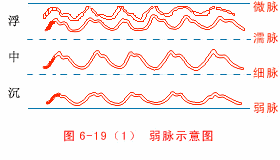
[Body Image Song] Weak pulse is small and soft, felt in the sinking section; it is barely felt when lifted, but can be felt when pressed.
[Main Disease Song] Weak indicates yang deficiency, true qi weakness. A weak pulse at the cun indicates heart deficiency, with anxiety and forgetfulness; a weak pulse at the right cun indicates lung deficiency, with spontaneous sweating and shortness of breath. A weak pulse at the left guan indicates liver injury, with blood not nourishing the muscles; a weak pulse at the right guan indicates spleen cold, with food not digesting. A weak pulse at the left chi indicates water decline, with weakness in the lower back and legs; a weak pulse at the right chi indicates fire decline, with cold symptoms.
15. Tight Pulse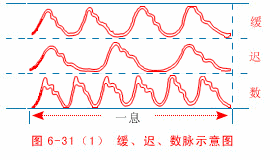
[Body Image Song] Tight pulse is strong, with a snapping quality; it feels like a twisted rope, like a tightly pulled string.
[Main Disease Song] Tight indicates cold evil, also indicating various pains. A tight pulse at the left cun indicates fullness and urgent pain; a tight pulse at the right cun indicates cold damage and wheezing. A tight pulse at the left guan indicates wind-cold; a tight pulse at the right guan indicates food stagnation. A tight pulse at the left chi indicates extreme pain below the navel; a tight pulse at the right chi indicates hernia.
16. Slow Pulse
[Body Image Song] Slow pulse is gentle and even, coming and going harmoniously; it feels like a gentle breeze, like willows in early spring.
[Main Disease Combined Pulse Song] Slow indicates stomach qi, not indicating disease; it must be combined with other observations to determine the diagnosis. Floating slow indicates wind damage, sinking slow indicates cold dampness. Slow large indicates wind deficiency, slow fine indicates damp obstruction. Slow rough indicates spleen deficiency, slow weak indicates qi deficiency. A floating slow pulse at the right cun indicates wind evil; a slow rough pulse at the left cun indicates blood deficiency.
17. Wiry Pulse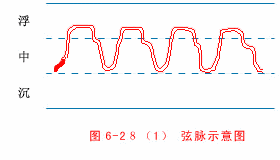
[Body Image Song] Wiry pulse is like a string, light and soft; it is straight and long, with a firm feel under the fingers.
[Main Disease Song] Wiry indicates liver wind, indicating pain, malaria, and phlegm. A wiry pulse at the left cun indicates heart pain; a wiry pulse at the right cun indicates chest and head pain. A wiry pulse at the left guan indicates phlegm and malaria; a wiry pulse at the right guan indicates stomach cold and diaphragm pain. A wiry pulse at the left chi indicates fluid in the lower jiao; a wiry pulse at the right chi indicates leg cramps and pain.
[Combined Pulse Song] Floating wiry indicates fluid retention, sinking wiry indicates fluid suspension. Wiry rapid indicates heat, wiry slow indicates cold. Wiry large indicates deficiency, wiry fine indicates tightness. Yang wiry indicates headache, yin wiry indicates abdominal pain. Single wiry indicates fluid retention, double wiry indicates cold accumulation.
18. Moving Pulse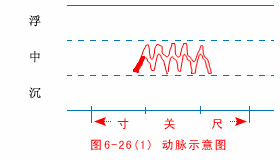
[Body Image Song] Moving pulse has no head or tail, its movement is like a bean; it shakes and sways, often accompanied by slippery and rapid qualities.
[Main Disease Song] Moving pulse indicates pain, also indicating shock. A moving pulse at the left cun indicates anxiety; a moving pulse at the right cun indicates spontaneous sweating. A moving pulse at the left guan indicates shock and spasms; a moving pulse at the right guan indicates heart and spleen pain. A moving pulse at the left chi indicates loss of essence; a moving pulse at the right chi indicates excessive fire.
19. Rapid Pulse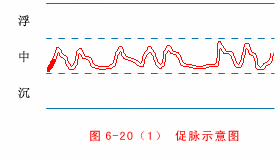
[Body Image Song] Rapid pulse is quick and frequent, with a stop every few beats; it is like a horse running, occasionally stumbling.
[Main Disease Song] Rapid pulse indicates excessive fire, also due to stagnation. A rapid pulse at the left cun indicates heart fire; a rapid pulse at the right cun indicates lung wheezing. A rapid pulse at the left guan indicates blood stagnation; a rapid pulse at the right guan indicates food stagnation. A rapid pulse at the left chi indicates excessive fluid; a rapid pulse at the right chi indicates heat and disaster.
20. Knotted Pulse
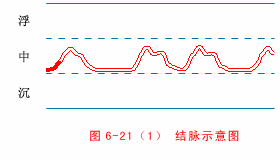
[Body Image Song] Knotted pulse indicates a binding sensation, with pauses in between; it moves slowly and lazily, often indicating a specific condition.
[Main Disease Song] Knotted indicates yin cold, also due to accumulation. A knotted pulse at the left cun indicates heart cold, with pain; a knotted pulse at the right cun indicates lung deficiency, with qi cold accumulation; a knotted pulse at the left guan indicates hernia; a knotted pulse at the right guan indicates phlegm stagnation and food retention. A knotted pulse at the left chi indicates weakness; a knotted pulse at the right chi indicates cold accumulation.
21. Intermittent Pulse
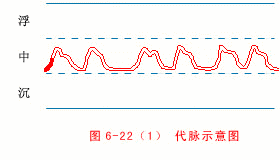
[Body Image Song] Intermittent pulse indicates a pause in rhythm, with a consistent pattern; it cannot return to normal, often taking a long time to resume movement.
[Main Disease Song] Intermittent indicates organ decline, a sign of danger. Spleen deficiency leads to vomiting and diarrhea; cold in the middle leads to abdominal pain and difficulty eating. Two movements and one pause indicate death within three to four days; four movements and one pause indicate death within six to seven days. Sequentially deducing, one does not lose the essence of the diagnosis.
22. Leather Pulse

[Body Image Song] Leather pulse is strong and tense, easily felt; it feels empty when pressed, like a drum skin.
[Main Disease Song] Leather indicates surface cold, also indicating internal deficiency. A leather pulse at the left cun indicates heart blood deficiency; a leather pulse at the right cun indicates metal decline and qi blockage. A leather pulse at the left guan indicates hernia; a leather pulse at the right guan indicates earth deficiency and pain. A leather pulse at the left chi indicates essence depletion; a leather pulse at the right chi indicates life-threatening conditions. Women may experience postpartum bleeding.
23. Solid Pulse
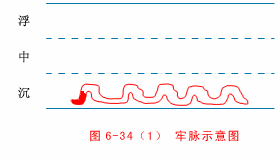
[Body Image Song] Solid pulse is strong and firm, felt in the sinking section; it is easily felt when pressed, but difficult to feel when lifted.
[Main Disease Song] Solid indicates accumulation. A solid pulse at the left cun indicates blockage; a solid pulse at the right cun indicates fullness. A solid pulse at the left guan indicates blood accumulation; a solid pulse at the right guan indicates cold and fullness. A solid pulse at the left chi indicates excessive movement; a solid pulse at the right chi indicates pain.
24. Scattered Pulse
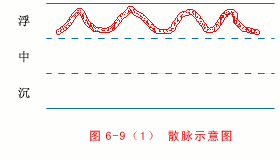
[Body Image Song] Scattered pulse is floating and chaotic, with surface but no internal; it gradually empties in the middle, and pressing it reveals nothing.
[Main Disease Song] Scattered indicates fundamental injury, indicating danger. A scattered pulse at the left cun indicates anxiety and insomnia; a scattered pulse at the right cun indicates spontaneous sweating. A scattered pulse at the left guan indicates fluid overflow; a scattered pulse at the right guan indicates fullness and illness. Located at the left chi indicates water depletion; a scattered pulse at the right chi indicates yang depletion and life-threatening conditions.
25. Floating Pulse
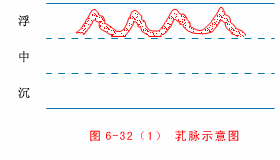
[Body Image Song] Floating pulse is like a grass name, resembling a kind of onion; it has both floating and sinking qualities, with the middle section being empty.
[Main Disease Song] Floating pulse indicates emptiness, hence indicating blood loss. A floating pulse at the left cun indicates heart blood loss; a floating pulse at the right cun indicates yin injury. A floating pulse at the left guan indicates liver blood not stored; a floating pulse at the right guan indicates spleen blood not absorbed. A floating pulse at the left chi indicates red urine; a floating pulse at the right chi indicates fire and essence leakage.
26. Hidden Pulse
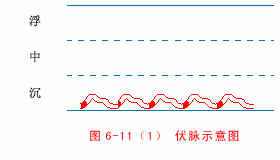
[Body Image Song] Hidden pulse is concealed, deeper than sinking; it feels like pushing muscles against bones, revealing its form.
[Main Disease Song] Hidden pulse is yin, indicating deep-seated illness. A hidden pulse at the left cun indicates blood stagnation; a hidden pulse at the right cun indicates qi stagnation. A hidden pulse at the left guan indicates liver blood in the abdomen; a hidden pulse at the right guan indicates cold accumulation in the stomach. A hidden pulse at the left chi indicates hernia; a hidden pulse at the right chi indicates fire depletion.
27. Rapid Pulse
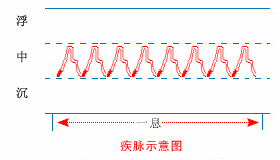
[Body Image Song] Rapid pulse is extremely quick, with a high frequency; it is characterized by seven to eight beats, flowing thinly and rapidly.
[Main Disease Song] Rapid pulse indicates extreme yang, with yin qi about to deplete; the pulse is irregular, indicating a potential loss of consciousness; it progresses rapidly, often leading to death. A rapid pulse at the left cun indicates danger; a rapid pulse at the right cun indicates fire consuming the body. A rapid pulse at the left guan indicates liver yin depletion; a rapid pulse at the right guan indicates spleen yin depletion. A rapid pulse at the left chi indicates extreme depletion; a rapid pulse at the right chi indicates excessive heat.

Overview of Pulse Diagnosis
(1) Floating Pulse Mnemonic:Floating lightly indicates excess, pressing shows deficiency; floating like wood on water, floating with strength indicates wind-heat, floating without strength indicates blood deficiency. Sinking pulse mnemonic: sinking heavy indicates pressure, the pulse appears like a stone thrown into water, sinking with strength indicates cold pain, sinking without strength indicates deficiency cold. Slow pulse mnemonic: slow pulse comes, three beats per breath; the pulse comes extremely slowly, remember in your heart; slow indicates organ disease or excess cold, carefully study between deficiency and excess.
(2) First, clarify the principle of pulse movement. Relying solely on memorization of over twenty pulse types is insufficient. The pulse movement is the arterial pulse, which belongs to yang; pulse diagnosis is essentially feeling the rise and fall of yang qi within the body. Blood returns through the inferior vena cava to the right atrium, then into the right ventricle, and then through the pulmonary veins into the lungs, where red blood cells combine with oxygen atoms before entering the left atrium, then into the left ventricle, and finally into the aorta to supply other organs.
The cun-kou pulse is specifically taken at the radial artery pulse point of the taiyin lung meridian. The three regions and nine positions refer to palpating the arterial pulses of other organs and meridians throughout the body. The lungs are where red blood cells combine with oxygen atoms, and the body’s operation is a continuous process of oxidation and reduction; thus, changes in the lung pulse reflect overall changes in the body, guiding how to adjust the body’s yin and yang.
You can imagine blood vessels as water pipes; under normal circumstances, water flows through the pipes, with pressure near the walls representing yang qi, and lower pressure in the center representing yin blood:
1. If yin deficiency is present, a light touch can feel the pulse (floating pulse, fine pulse);
2. If yang deficiency is present, the wall pressure is low, requiring deeper pressure to feel the pulse (sinking pulse, stone pulse);
3. If blood is insufficient, qi loses its nourishing ability, leading to both qi and blood deficiency, resulting in poor flow (rough pulse, floating pulse);
4. Chronic illness leads to qi deficiency, with low pulse pressure (fine pulse, small pulse), and blood flow becomes slow (slow pulse, gentle pulse);
5. Yin deficiency and yang excess (rapid pulse, long pulse);
6. Blood flow obstruction leads to stasis (knotted pulse, intermittent pulse).
Wind belongs to yang evil, which can cause the pulse to beat excessively; cold belongs to yin evil, which has a constricting nature that can cause the pulse to feel tight; fire belongs to yang, which can cause the pulse to beat rapidly; dampness belongs to yin evil, which can cause the pulse to slow down or pause; heat is a yang evil but often accompanied by dampness, which can cause the pulse to feel tight, small, slow, and rough.
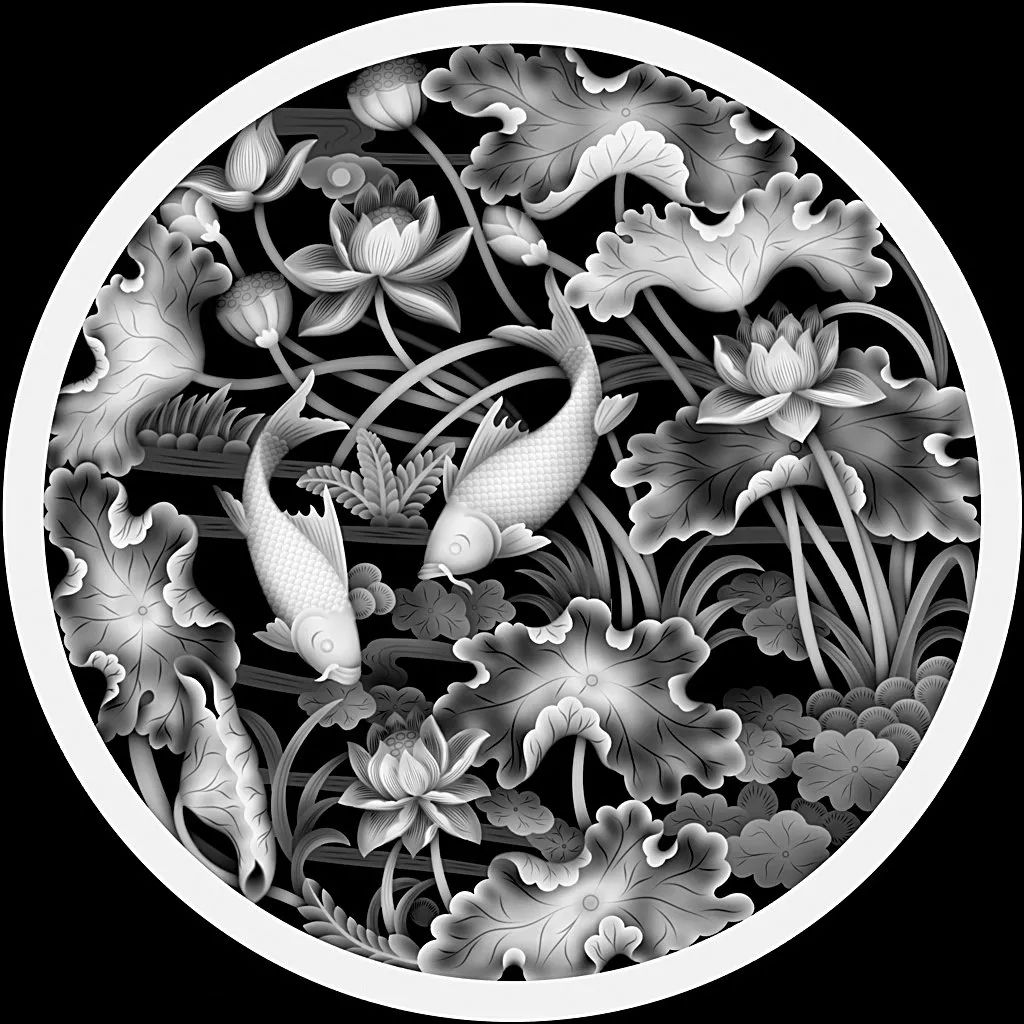
Mnemonic for Pulse Diagnosis
The method of pulse diagnosis has true transmission; the twenty-eight pulses are not ordinary,
Floating, sinking, slow, and rapid are the four main pulses, each pulse type must be studied in detail.
Floating encompasses five pulses that must be clearly examined (moist, leather, surging, fine, scattered)
Sinking includes four pulses that must be heavy (hidden, fine, solid, weak)
Floating and sinking include four pulses (deficient, excess, rough, long)
1. Floating Pulse
Floating lightly indicates excess, pressing shows deficiency; floating like wood on water,
Floating with strength indicates wind-heat, floating without strength indicates blood deficiency.
2. Sinking Pulse
Sinking heavy indicates pressure, the pulse appears like a stone thrown into water,
Sinking with strength indicates cold pain, sinking without strength indicates deficiency cold.
3. Slow Pulse
Slow pulse comes, three beats per breath; the pulse comes extremely slowly, remember in your heart,
Slow indicates organ disease or excess cold, carefully study between deficiency and excess.
4. Rapid Pulse
Rapid pulse comes, six beats per breath; the pulse comes quickly, remember in your heart,
Floating, sinking, deficient, and excess must be distinguished; the fire of the monarch and minister is treated differently.
5. Weak Pulse
Weak pulse is without strength, floating large and soft without root;
Weak pulse indicates heat in the body, qi deficiency leads to weakness.
6. Strong Pulse
Strong pulse is large and long, with all three sections filled with strength,
New diseases show strong evil qi, while chronic diseases show signs of disaster.
7. Slippery Pulse
Slippery pulse is difficult to interpret, like beads rolling under the fingers;
Food stagnation and phlegm fullness in the chest; women’s pulse should indicate pregnancy.
8. Rough Pulse
Rough pulse is like cutting bamboo, fine and slow, indicating fear;
Blood deficiency and qi stagnation; women may not menstruate if not pregnant.
9. Surging Pulse
Surging pulse is large, like waves; it comes strong and goes gently,
Surging indicates excessive evil qi, fullness in the stomach is difficult to treat.
10. Fine Pulse
Fine pulse is thin, barely felt; it is almost imperceptible, yet not completely absent.
Excessive labor leads to qi and blood deficiency; sudden illness is difficult to treat.
11. Tight Pulse
Tight pulse is strong, with a snapping quality; it feels like a twisted rope,
Cold injuries indicate pain; floating and sinking must be clearly distinguished.
12. Slow Pulse
Slow pulse is gentle and even, coming and going harmoniously;
It may indicate spleen deficiency and wind-damp disease; it is not a disease, but requires careful evaluation.
13. Moist Pulse
Moist pulse is fine and soft, like floating cotton; it is weak and without strength,
Postpartum conditions may show this pulse; healthy individuals should not worry.
14. Weak Pulse
Weak pulse is small and soft, felt in the sinking section; it is barely felt when lifted, but can be felt when pressed.
Yang qi is weak, essence and blood are deficient; older individuals may show this, but younger individuals may not.
15. Long Pulse
Long pulse is long and straight, with both ends clear; it moves straight up and down,
Long indicates strong heart and kidney foundation; long and hard indicates fire excess.
16. Short Pulse
Short pulse is small and tight, with both ends curled; it protrudes in the middle, unable to fill the entire section.
Short indicates various diseases that are difficult to treat, often due to true essence deficiency.
17. Floating Pulse
Floating pulse is like a grass name, resembling a kind of onion; it has both floating and sinking qualities, with the middle section being empty.
Floating pulse indicates emptiness, hence indicating blood loss; a floating pulse at the left cun indicates heart blood loss.
18. Wiry Pulse
Wiry pulse is like a string, light and soft; it is straight and long, with a firm feel under the fingers.
Wiry indicates liver wind, indicating pain, malaria, and phlegm; a wiry pulse at the left cun indicates heart pain.
19. Scattered Pulse
Scattered pulse is floating and chaotic, with surface but no internal; it gradually empties in the middle, and pressing it reveals nothing.
Scattered indicates fundamental injury, indicating danger; a scattered pulse at the left cun indicates anxiety and insomnia.
20. Hidden Pulse
Hidden pulse is concealed, deeper than sinking; it feels like pushing muscles against bones, revealing its form.
Hidden pulse indicates deep-seated illness; a hidden pulse at the left cun indicates blood stagnation.
21. Rapid Pulse
Rapid pulse is extremely quick, with a high frequency; it is characterized by seven to eight beats, flowing thinly and rapidly.
Rapid pulse indicates extreme yang, with yin qi about to deplete; the pulse is irregular, indicating a potential loss of consciousness.
22. Leather Pulse
Leather pulse is strong and tense, easily felt; it feels empty when pressed, like a drum skin.
Leather indicates surface cold, also indicating internal deficiency; a leather pulse at the left cun indicates heart blood deficiency.
23. Solid Pulse
Solid pulse is strong and firm, felt in the sinking section; it is easily felt when pressed, but difficult to feel when lifted.
Solid indicates accumulation; a solid pulse at the left cun indicates blockage.
24. Scattered Pulse
Scattered pulse is floating and chaotic, with surface but no internal; it gradually empties in the middle, and pressing it reveals nothing.
Scattered indicates fundamental injury, indicating danger; a scattered pulse at the left cun indicates anxiety and insomnia.
25. Floating Pulse
Floating pulse is like a grass name, resembling a kind of onion; it has both floating and sinking qualities, with the middle section being empty.
Floating pulse indicates emptiness, hence indicating blood loss; a floating pulse at the left cun indicates heart blood loss.
26. Hidden Pulse
Hidden pulse is concealed, deeper than sinking; it feels like pushing muscles against bones, revealing its form.
Hidden pulse indicates deep-seated illness; a hidden pulse at the left cun indicates blood stagnation.
27. Rapid Pulse
Rapid pulse is extremely quick, with a high frequency; it is characterized by seven to eight beats, flowing thinly and rapidly.
Rapid pulse indicates extreme yang, with yin qi about to deplete; the pulse is irregular, indicating a potential loss of consciousness.

Overview of Pulse Diagnosis
(1) Floating Pulse Mnemonic:Floating lightly indicates excess, pressing shows deficiency; floating like wood on water, floating with strength indicates wind-heat, floating without strength indicates blood deficiency. Sinking pulse mnemonic: sinking heavy indicates pressure, the pulse appears like a stone thrown into water, sinking with strength indicates cold pain, sinking without strength indicates deficiency cold. Slow pulse mnemonic: slow pulse comes, three beats per breath; the pulse comes extremely slowly, remember in your heart; slow indicates organ disease or excess cold, carefully study between deficiency and excess.
(2) First, clarify the principle of pulse movement. Relying solely on memorization of over twenty pulse types is insufficient. The pulse movement is the arterial pulse, which belongs to yang; pulse diagnosis is essentially feeling the rise and fall of yang qi within the body. Blood returns through the inferior vena cava to the right atrium, then into the right ventricle, and then through the pulmonary veins into the lungs, where red blood cells combine with oxygen atoms before entering the left atrium, then into the left ventricle, and finally into the aorta to supply other organs.
The cun-kou pulse is specifically taken at the radial artery pulse point of the taiyin lung meridian. The three regions and nine positions refer to palpating the arterial pulses of other organs and meridians throughout the body. The lungs are where red blood cells combine with oxygen atoms, and the body’s operation is a continuous process of oxidation and reduction; thus, changes in the lung pulse reflect overall changes in the body, guiding how to adjust the body’s yin and yang.
You can imagine blood vessels as water pipes; under normal circumstances, water flows through the pipes, with pressure near the walls representing yang qi, and lower pressure in the center representing yin blood:
1. If yin deficiency is present, a light touch can feel the pulse (floating pulse, fine pulse);
2. If yang deficiency is present, the wall pressure is low, requiring deeper pressure to feel the pulse (sinking pulse, stone pulse);
3. If blood is insufficient, qi loses its nourishing ability, leading to both qi and blood deficiency, resulting in poor flow (rough pulse, floating pulse);
4. Chronic illness leads to qi deficiency, with low pulse pressure (fine pulse, small pulse), and blood flow becomes slow (slow pulse, gentle pulse);
5. Yin deficiency and yang excess (rapid pulse, long pulse);
6. Blood flow obstruction leads to stasis (knotted pulse, intermittent pulse).
Wind belongs to yang evil, which can cause the pulse to beat excessively; cold belongs to yin evil, which has a constricting nature that can cause the pulse to feel tight; fire belongs to yang, which can cause the pulse to beat rapidly; dampness belongs to yin evil, which can cause the pulse to slow down or pause; heat is a yang evil but often accompanied by dampness, which can cause the pulse to feel tight, small, slow, and rough.

Mnemonic for Pulse Diagnosis
The method of pulse diagnosis has true transmission; the twenty-eight pulses are not ordinary,
Floating, sinking, slow, and rapid are the four main pulses, each pulse type must be studied in detail.
Floating encompasses five pulses that must be clearly examined (moist, leather, surging, fine, scattered)
Sinking includes four pulses that must be heavy (hidden, fine, solid, weak)
Floating and sinking include four pulses (deficient, excess, rough, long)

